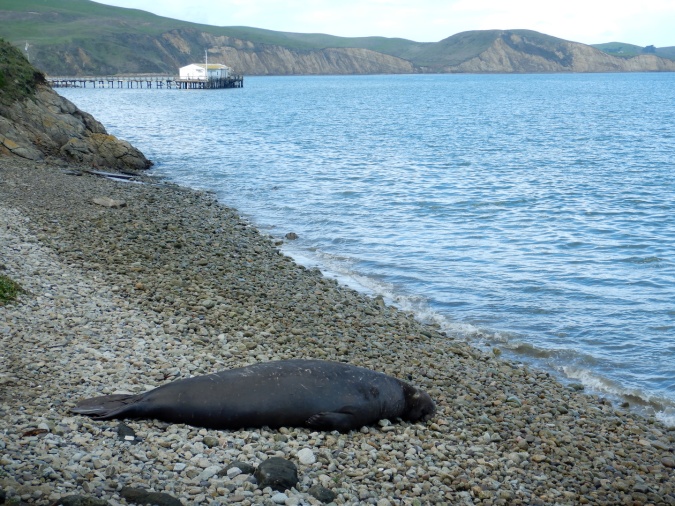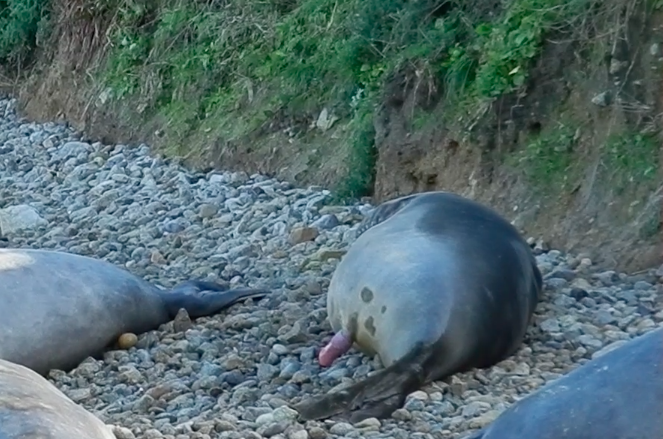Northern elephant seals are one of the largest pinnipeds on Earth. Large males can weigh as much as an SUV—four to five thousand pounds. Females are much smaller, topping off at only about one thousand pounds. Since the first few pairs began to haul out at Point Reyes in the 1970s, more and more have arrived each year.

A subadult male elephant seal rests on a cobble beach in the Chimney Rock area at Point Reyes National Seashore.
This aggregation is a seasonal event. Unlike many mammals, the birthing and breeding season coincide in elephant seals. Males arrive first, establishing beach front territory where they’ll be able to establish and protect a harem. Pregnant females show up next, after which they soon give birth. Pups are weaned after about a month of nursing. Like bears, female elephant seals fast while giving birth and nursing. They do not eat, drink, or leave the beach during this time. Consequently, they lose 30-40% of their body weight during this short time. Mating occurs before the females depart to the open ocean. Adult males stick around longer, aiming to increase their chances of mating with as many females as possible.
Males have unique individual calls, and helps them recognize each other and avoid some physical conflict. While my mid January visit was too brief and my viewing was too far away to make such differentiations, there was plenty of activity to see and hear.
The biggest bulls already had established territories and harems. Newborn pups cried nearly constantly, especially when a wave of cold water washed over them. Females barked at each other too. For gregarious creatures, they sure let others hear it when their personal space is encroached upon.
(This place could really benefit from a webcam.)
The main overlook provided the best viewing opportunity to see bulls with harems. The females didn’t seem to be ready to mate, having just given birth or just about to, but that didn’t stop some of the bulls from trying. Forced copulation is not uncommon among elephant seals. Females can be seriously injured and pups crushed by randy males.
I also found good viewing opportunities nearby at the old U.S. Life Saving Station.

I had no idea what was going on here, but later learned this is an elephant seal’s penis. (Also, I’m told, these are nicknamed a “pink floyd.”)
Northern elephant seals were once thought to be extinct from decades of unrelenting and unregulated hunting, then a small population was found off of the Mexican coast in the early twentieth century. Luckily, the species was given strict protection while their ocean habitat remained largely intact, and their population has grown about six percent per year since the early twentieth century. There are now probably more than 150,000 northern elephant seals.
Many marine mammal species were once so rare that we can’t take them for granted, and we need to ensure their habitat and food sources are protected. If you’re in the neighborhood of Point Reyes National Seashore in January and February, you must stop and see elephant seals at Chimney Rock.
Thank you, Mike, for your postings. I learn something new every time!
LikeLike
Mike, We drove out to Point Reyes for first time in early February. What a treat to discover elephant seals! Noisy beach in. Beautiful sunny warm winter day. You bet, they need a web cam like Katmai. We needed our binoculars and telephoto lens. Next time. A couple migrating gray whales had been spotted the day we were there. Love your wandering blog. Sent from my iPhone
>
LikeLike
Ranger Mike, Very interesting read on Elephant seals. Do you happen to know how many pups that a female normally gives birth to? I suppose like a grizzly the males responsibility ends with copulation?
Thanks, Tom
Sent from my iPad
>
LikeLike
Elephant seals usually just have one pup. From what I’ve read, twins are extremely rare. Like bears, males play no role in rearing the pups, but the mother’s role is limited as well. Mothers nurse their pups for four weeks or so. After weaning, the pups (now called “weaners”) are abandoned to learn to swim and feed on their own. This paper summarizes the weaners first few weeks of life.
LikeLike